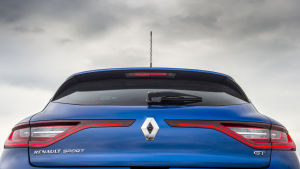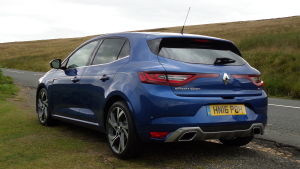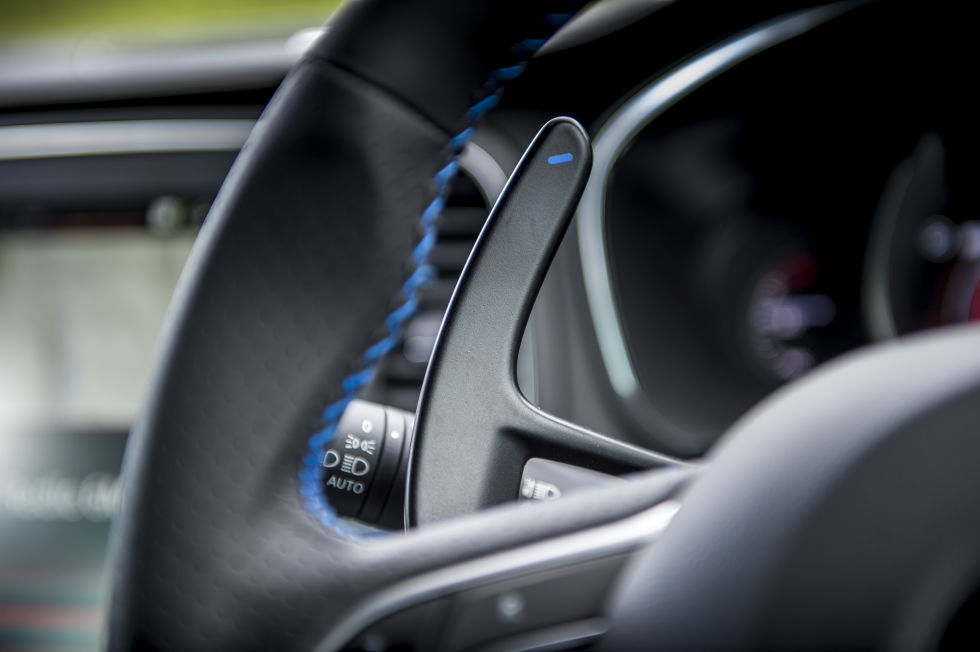-
The Megane is certainly handsome, maybe even sexy.Alun Taylor
-
Wide LED running lights offer a touch of visual flair.Alun Taylor
-
Sculpted flanks reflect the light.Alun Taylor
-
A 1.6L turbo four-pot engine has 205bhp. That's enough.Alun Taylor
-
The GT is hottest version until the 2018 RS arrives.Alun Taylor
-
The new Megane: clearly a van den Acker design.Alun Taylor
-
Air intake and scoops unique to GT model.Alun Taylor
-
The boot is large but lip high.Alun Taylor
-
The new Megane is only available as a five-door.Alun Taylor
-
A diffuser and twin pipes shows sporty intent.Alun Taylor
-
The signature Renault diamond is prominant on the nose.Alun Taylor
-
This is an F1-style fuel filler nozzle.Alun Taylor
-
All-important RenaultSport badges abound.Alun Taylor
"Anonymous" would be the word I use when asked to describe the designs of the current crop of mainstream c-segment (medium-sized) hatchbacks currently on sale in Europe.
VW’s Golf? Utterly anonymous. Vauxhall's five-door Astra? Stupefyingly anonymous. Peugeot’s 308? Depressingly anonymous. Toyota’s Auris? Alarmingly anonymous. The Ford Focus stands out—but only because it has a nose pinched from Aston Martin.
Don’t get me wrong, these cars all have merit, some in spades, but visually inspiring they are not. Into this rather vapid assembly now drops Renault’s fourth-generation Mégane, the latest in a line of cars that stretches back to 1995, selling over 6.5 million units. It’s a car I’ve been looking forward to driving because all of Renault’s recent efforts under their current design chief Laurens van den Acker have been really rather good.
The Clio, Captur, Kadjar, and the not-available-in-right-hand-drive Espace have all tickled my fancy, and so I took to the Pennine roads in the new Renault Sport-developed GT model hoping to be equally impressed.
Va va voom


Taken in the round I’d call even the base models well resolved and rather dashing. Add the GT’s honeycomb-mesh-covered lower air intake, side scoops, rear diffuser, and 18-inch alloys to the mix and you could even call the thing sexy. For instance, the always-on rear LED running lights that span the width of the car from each side of the Renault diamond on the hatch are a nice visual touch.
Since the GT is plastered with Renault Sport badges, a few words about performance are probably in order. Firstly this is not the hottest Mégane we're going to get; a full-fat, fire-breathing RS version will arrive in 2018. Like the GT it will be a five-door hatch, so there won’t be a Mégane coupé this time around.

There’s no manual option, only a seven-speed automatic dual-clutch affair complete with flappy paddles. Don’t worry about the absence of a traditional gearstick. It’s a good transmission, quick to change up and down and hard to fluster.
Change down in manual mode and something Renault calls "Multi-Change Down" comes into play. This drops the cogs down several ratios in rapid succession under braking, all the better to shoot you out of the corner when you put the power down. It’s a bit of a boy-racer feature but it put a smile on my face.
This being a sporty Renault you also get launch control. Put your foot on the brake pedal, pull the two gearshift paddles forward, hold them, and wait for activation to be confirmed by a "Launch Control On" message on the instrument panel. With your right foot pressed down on the accelerator, launch control activates as soon as the brake pedal is released. Fun ensues.
What all this performance kit, and the Renault Sport-tuned suspension does is make the GT an easy car to drive quickly. Granted it lacks the absolute fidelity of the Golf GTI or the raw pace of the Civic Type R, and the ride can sometimes be a little unforgiving on poor surfaces, but you don’t need to be a pro to get between places quickly and safely. Even during a torrential downpour on the north Pennine moors, the Mégane proved a sure-footed yet agile machine.

| Specs: 2016 Renault Mégane GT | |
|---|---|
| Body type | 5-door hatchback |
| Layout | Front engine, front wheel drive |
| Powertrain | 1.6L four cylinder turbo |
| Transmission | Seven speed dual-clutch automatic |
| Horsepower | 205bhp (153kW) |
| Torque | 208ft-lbs (282Nm) |
| Steering | 4Control four-wheel steering |
| Suspension | Pseudo MacPherson (front) / Torsion beam (rear) |
| Tyres | 225/40R18 |
| Top speed | 145mph (233km/h) |
| Combined fuel economy | 47.1mpg |
| Internet connectivity | Free for 12 months with R-Link 2 |
| Weight | 1,463kg (3225lbs) |
| Wheelbase | 2669mm (105in) |
| Dimensions | 4359 (171.6in) x 1818 (71.5in) x 1447mm (59.6in) (LWH) |
| Base price | £28,575 (as tested) |
Hooning it like a hooligan
Of course this being 2016, if you decide don’t want your gear shifts and engine mapping set to hooligan mode, you can change them using the Multi-Sense menu. The new Mégane comes with no less than five comfort and performance settings, and for once they actually do something other than change the colour of the instrument panel and cabin lighting.
In Sport mode the engine and gearbox are turned up to eleven, the engine noise is enlarged, the four-wheel steering—I’ll come back to this—is given the most range, the steering is weighted, and the air con is boosted to the max to keep you cool. In Comfort, everything bar the suspension gets a lot more soft and serene, while Neutral puts you someplace in between. In Eco mode (missing from the GT) everything is turned down to save fuel, and the planet.
If none of the presets suits, you can individually adjust the engine mapping, gear-change severity, steering effort, four wheel-steer degree, air conditioning, and engine sound to create a personal, or "Perso" in Renault-speak, mode.
After much mucking about I settled on a mode which copied across all of the Sport settings but dialled back the amount of teenager in the gear change—for my taste it held onto first and second just a wee bit too long, making it hard to drive through built-up areas without the locals thinking you were being a deliberate prat.
I suspect most drivers will simply alternate between the Sport and Comfort modes. Flipping between the two really does make for a dramatic change in the overall feel of the car. One is perfect for hooning across the moors, the other ideal for running your granny down to the hospital for her hip replacement.
Incidentally, if you are in one of the more relaxed modes when the red mist descends, there is a button on the centre console marked "R.S. Drive" that will pop you right back into the undiluted Sport setup.
reader comments
23